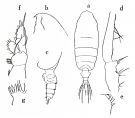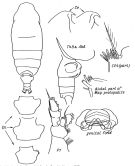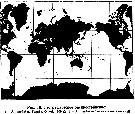|
|
 |
|
Calanoida ( Order ) |
|
|
|
Clausocalanoidea ( Superfamily ) |
|
|
|
Aetideidae ( Family ) |
|
|
|
Pseudochirella ( Genus ) |
|
|
| |
Pseudochirella tanakai Markhaseva, 1989 (F, ?M) | |
| | | | | | | Syn.: | Pseudochirella pustulifera : Tanaka, 1957 b (p.192, figs.F); Tanaka & Omori, 1969 a (part., p.162, no F, ? figs.M); ? Hattori, 1991 (tab.1, Appendix) | | | | Ref.: | | | Markhaseva, 1989 (p.34, Rem.F, figs.F); Markhaseva & Razzhivin, 1993 (p.612); Markhaseva, 1996 (p.290, figs.F, p.293: Notes p.293: M) |  issued from : Tanaka O. in Publ. Seto mar. Biol., Lab., 1957, 6 (2). [Fig.54, p.193]. As Pseudochirella pustulifera. Female: a, habitus (dorsal aspect); b, head (lateral aspect, left side); c, last thoracic segment and urosome (lateral aspect); d, basal joints of Mxp.; e, distal margin of first basal joint of Mxp.; g, inner margin of first basal joint of P4. Nota Female: - Cephalothorax about 1.8 times the abdomen length (4.95 : 1.31). - Head and 1st pedigerous segment incompletely separate, 4th and 5th pediger segments separate. - Rostrum strong, directs backwards. - Frontal organ prominent. - Lateral corners of last thoracic segment rounded. - Abdomen 4-segmented; segments and caudal rami in proportional lengths 43 : 19 : 14 : 10 : 14 = 100. - Genital segment with a remarkable protuberance on each side of the segment (more peominent than those figured as P. pustulifera by previous authors. - 2nd abdominal segment setose ventrally. - Distal margin of 2nd and 3rd abdominal segments frilged with fine teeth. - Caudal rami as long as wide. - A1 23-segmented, extends to distal end of 3 rd abdominal segment; segments 8-9, 13-14 about equal lengths; segment 19 the longest. - A2 exopod 1.6 times as long as endopod (43 : 26); posterior surface of 1st basal segment with a tuft of hairs. - Md robust, carries 3 setae on 2bd basal segment; biting part with strong teeth. - Mx1 exopod with 11 setae; outer lobe with 7+2 setae; 1st endopodal segment with 4 setae, 2nd segment with 5 setae, 3rd with setae; 2nd basal segment with 5 setae; 3rd inner lobe with 4 setae and a conical process; 2nd inner lobe with 5 setae. - Mx2 very robust. - Mxp with a small conical process on 4th lobe of 1st basal segment. - P1: articulation between 1st and 2nd exopodal segment distinct only on the anterior surface.P2: articulation between 1st and 2nd endopodal segment observed on the anterior surface; terminal exopodal spine with about 74 teeth. P4: coxa with 6 fairly long spines on the inner margin. - Some mouth appendages and swimming legs are of crimson colour.
|
 issued from : E.L. Markhaseva in Proc. Zool. Inst. RAN, St. Petersburg, 1996, 268. [p.294, Fig.237]. Female (from Markhaseva, 1989). Ce: forehead lateral (variability of trostrum); Gn: genital segment (dorsal view); CP4: coxopod of fourth leg (partial). Nota Female: - Cephalothorax about 3.8-4.4 times longer than urosome. -Posterior corners of last thoracic segment rounded and symmetrical. - Genital segment with projections on the right and left, slightly asymmetrical, forming type of shoulders of the segment. - A1 reaching nearly the midlength of urosome, or about as long as body. - Exopod of P1 incompletely 3-segmented. - Endopodite of P2 indistinctly 2-segmented. - Coxopodite of P4 with 4-7 spines. Nota Male : Complement (after Tanaka & Omori, 1969, with modifications): - Cephalothorax about 3 times longer than urosome. - Cephalon and thoracic segment 1 fused, 4th and 5th thoracic segments fused. - Posterior corners of last thoracic segment rounded, spines absent. - A1 reaching distal border of urosomal segment 2. - Exopod of A2 as long as endopod; endopodite segment 2 with 6 long setae on external lobe and 7 long and 1 small setae on internal lobe. - Mx1 with 7 setae on external lobe; exopod with 11 setae; endopod with 13, protopodite near endopod base with 5 setae; 3rd internal lobe with 4 setae; 2nd internal lobe with 2 reduced setae. - Exopod of P1 3-segmented; 1st segment with external spine very small. - Exopodal segment 2 of left P5 with a tooth on distal border. Markhaseva notes that the present male was described by Tanaka & Omori (1969) under the name P. pustulifera (Sars) together with female that was later considered independant species P. tanakai by Markhaseva (1989), however the status of the male is still doubtful
|
 issued from : O. Tanaka & M. Omori in Publ. Seto Mar. Biol. Lab., 1969, XVII (3). [p.163, Fig.3). As Pseudochirella pustulifera. Male (from Izu Region, Japan): a, forehead (lateral); b, last thoracic segment and urosome (left lateral); c,Mx1; d, P1; e, P5; f, 2nd and 3rd segments of exopod of left P5. Nota Male: - Cephalothorax and abdomen in the proportional lengths of 74 : 26. - Head and 1st pediger segment fused, 4th and 5th pediger segments fused. - Frontal margin of the head rounded. - Lateral corners of last thoracic segment not produced, but smoothly rounded. - Rostrum long and curved, directed posteriorly downwards. - Abdomen 5-segmented; segments and caudal rami in proportional lengths 17 : 30 : 20 : 19 : 2 : 12 = 100. - 2nd to 4th abdominal segments fringed with spinules on distal margin. - Caudal rami as long as wide.. - A1 23-segmented. - A2 exopod as long as endopod; endopod furnished with 6 long setae on the outer lobe, and 7 long and a minute setae on the inner lobe. - Mx1 with 7 setae on the outer lobe; 11 setae on exopod; 5+4+4 setae on endopod; 5 setae on the 2nd basal segment; 4 setae on the 3rd inner lobe; 2 rudimentary setae on the 2nd inner lobe; and 7 rudimentary setae on the 1st inner lobe (= arthrite). - P1 with exopod 3-segmented, endopod 1-segmented; 1st exodopodal segment with an outer marginal spine. - P5 has a similar structure to that of P. polyspina, but the 2nd exopodal segment of left leg furnished with single process on the inner distal margin: this pointed process is accompanied with a semicircular striated process.
|
 Issued from : E.L. Markhaseva in USSR Acad. Sci., Zool. Inst., Explor. Fauna Seas. Marine Plankton, 1989, 41 (49). [p.52, Fig.13]. Female: Thoracic segment 5 and genital segment. Nota from the key: 1 - Genital segment slightly asymmetrical. 2 - Thoracic posterior corners rounded. 3 - Thoracic posterior corners symmetrical. 4 - Genital segment with large shoulder-like swellings in its anterior part (dorsal view).
|
 issued from : O. Tanaka & M. Omori in Publ. Seto Mar. Biol. Lab., 1969, XVII (3). [p.163]. As Pseudochirella pustulifera. Male A1: proportional length of segments. - A1 extends about to the distal margin of the 2nd abdominal segment. - Segments 12 and 13 partially fused.
| | | | | Compl. Ref.: | | | Galbraith, 2009 (pers. comm.) | | | | NZ: | 3 | | |
|
Distribution map of Pseudochirella tanakai by geographical zones
|
| | |  Issued from : E.L. Markhaseva in Issled. Fauny Morei, 1989, 41 (49). [p.59, Fig.18]. Issued from : E.L. Markhaseva in Issled. Fauny Morei, 1989, 41 (49). [p.59, Fig.18].
Geographical distribution of P. tanakai.
4: from literature; 5: present occurrence. |
| | | | Loc: | | | Japan (Izu, ? off Sanriku), Kuril-Kamchatka Trench, Vancouver Is.
Type locality: NW Pacific (Kuril Trench).
Type locality: NW Pacific (Kuril Trench). | | | | N: | 5 | | | | Lg.: | | | (37) F: 6,45-5,7; M: 5,51; (56) F: 6,26; (111) ? M: 5,51; {F: 5,70-6,45; M: 5,51} | | | | Rem.: | bathy & abyssopelagic.
After Markhaseva (1996, p.293) the status of the male from Tanaka & Omori, 1969 a) is still doubtful. | | | Last update : 17/04/2017 | |
|
|
 Any use of this site for a publication will be mentioned with the following reference : Any use of this site for a publication will be mentioned with the following reference :
Razouls C., Desreumaux N., Kouwenberg J. and de Bovée F., 2005-2025. - Biodiversity of Marine Planktonic Copepods (morphology, geographical distribution and biological data). Sorbonne University, CNRS. Available at http://copepodes.obs-banyuls.fr/en [Accessed October 22, 2025] © copyright 2005-2025 Sorbonne University, CNRS
|
|
 |
 |







